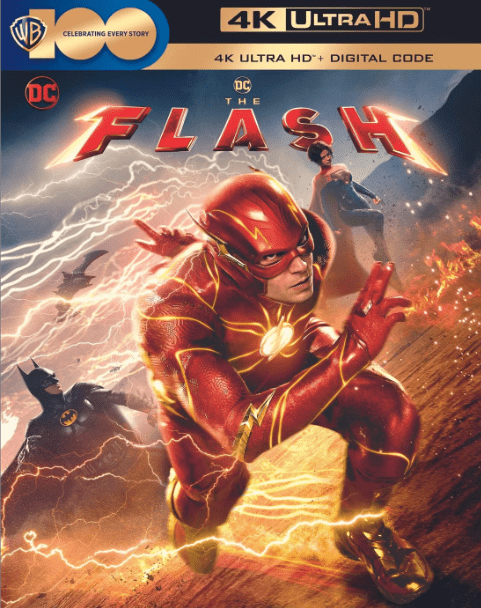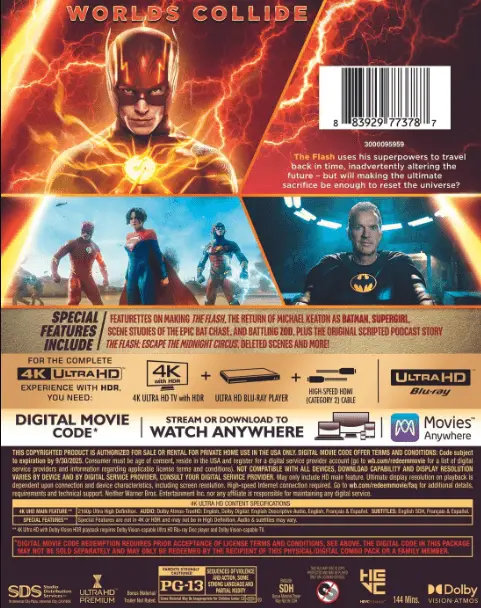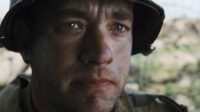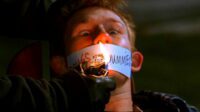The much-maligned The Flash arrives on store shelves on August 29th after enjoying a month on PVOD and early streaming platforms, including the Warner Bros-owned MAX. The would-be blockbuster film will be branded as part of the studio’s year-long 100th anniversary celebration, and will be available in 4K-UHD, Blu-ray, and DVD packages. As part of Film Obsessive’s “Off the Shelf” series, we took a look at an advanced 4K-UHD copy of The Flash.
The Movie
The Flash, directed by It series steward Andy Muschietti, was previously reviewed on Film Obsessive by Aqib Rasheed and recently was half of the target subject (alongside Spider-Man: Across the Spider-Verse of an excellent editorial on trauma written by James Y. Lee. Both pieces offer thorough details and excellent assessments of the film. Be sure to check those articles out here on our site before diving into this one.
If an unintentional theme could be assigned to The Flash on physical media it would be: Putting Your Best Face Forward. Through little fault of its own, the film became both a torch bearer for some things and a stretcher bearer for others. For many, The Flash was a bright shining hope of nostalgia and a chance to waft some of the last lingering vapors of the defunct Snyder-verse. This was the big one that had the potential to right the DCEU ship.
Then came the long production delays, studio upheaval, and the very public criminal struggles of its star Ezra Miller. Promise faded quickly and The Flash became cocooned in ugly controversies and burdensome bad mojo. Now that it’s reached this physical media finish line, the studio and all involved are trying their damnedest to hide its flaws (and main star) and highlight what was good about their efforts.
The Disc
With that in mind, the disc doesn’t start all that special or elicit much confidence. For years now, Warner Bros. has scaled their menu detail to the bare minimum. The options and choices occupy a plain bottom bar and the menu music gives up trying to draw or keep your attention in less than two minutes. We all remember the hey-day of DVDs having inventive menus that acted as a substitute pre-film overture that set the mood. Someone needs to bring those back, but, we know full well after a year-and-change, that it won’t be Warner Bros., century birthday be damned.
However, hiding within these plain Jane menus on The Flash is a surprisingly sizable amount of behind-the-scenes content and special features. There are, in all, ten featurettes in an era when we’re lucky to get three to five. The big, curious question on many minds will be how much Ezra Miller appears on The Flash’s special features. Well, out of ten featurettes, only two have moments with them pulled aside on the studio chair for camera time discussing their insight or work. That means the anointed new stars of this disc become director Andy Muschietti and his producer sister Barbara.

Loyal readers of “Off the Shelf” have heard this author lament about the lack of depth and detail given nowadays to captured behind-the-scenes content, especially from WB. The norm has become a 7-10-minute hyper-edited reel of banal voiceovers talking over the snippets of footage from the actual shoot. The mics from the set are omitted for over-explanation. They don’t let us watch and witness how it all was created.
Main Featurette
With high praise, The Flash sprints past that trend. It boasts the best production diary feature seen in several years from Warner Bros. For over 40 minutes, the disc’s “Making The Flash: Worlds Collide” chronicles the entire film’s shoot–under the working title guise of Baby Shower—in a thorough and comprehensive fashion. Andy and Barbara do most of the talking and granted the promotional team unfettered access to the sets and spaces from the first day of production to the last.
What is observed on “Making The Flash: Worlds Collide” is an odyssey in pandemic filmmaking challenges and revered acknowledgement of big moments when they happened. From the construction and use of the largest Bat Cave ever created for film and more chosen locations, the featurette shows off a heap of practical filmmaking varnished (probably over-varnished) by the digital tools available to make things pop.
The gruff and tough stunt coordinator Eunice Hutheart is scene-stealer in this feature describing the preparations and executions of the heavy stunt work employed in the film. Another fascinating point of focus is Ed Wade, the on-set acting double of Ezra Miller who went through as many wringers (if not more) than his big-name partner. Watching his work and hearing his insight (often as a substitute to the scrubbed Miller) is fascinating.
The Flash was the longest film shoot of Andy Muschietti’s career and he was not shy to show that fatigue. Much of the levity came when the power players joined the foray. Good chunks of time and on-set worship were paid to Michael Keaton, Ben Affleck, and Gal Gadot from their inclusion of the upper-level heroes they play. Keaton, in particular, impressed everyone and it shows. Sadly, only Gal Gadot got some face time reflecting in this featurette. Ben and Michael either declined or were not involved. Hearing from Keaton would have been a treat.
Other Featurettes
Beyond this big one, there are five sidebar featurettes for The Flash that go one level or so deeper into their particular focus than the main documentary. Just like the finished film itself, anything involving Michael Keaton towers above the rest. His feature, “Let’s Get Nuts: Batman Returns, Again!” borrows a 1989 Batman quote while sounding like a 1966 TV episode title. “Let’s Get Nuts” goes into the backstory bridging when we last saw Keaton as Batman in 1992 to the senior age shown in The Flash. It fills in blanks not shown in the final film and counts as a minor miss for The Flash itself. Like the main feature, it’s everyone but Keaton himself (more costume designer Dan Grace than anyone else) talking about the legend’s momentous appearance.
The other four featurettes– “The Bat Chase,” “Saving Supergirl,” “Battling Zod,” and “Fighting Dark Flash”– do their part to show off action set pieces and the work it took to pull them off. Muschietti again takes the lead next to production designer Paul Austerberry and cinematographer Harry Braham in explaining purpose and craft. With becoming a third iteration of his character, “Fighting Dark Flash” is the one time in these sub-features where the studio included Ezra Miller talking about any details of the production. It makes one wonder how much of their perspective was omitted. It’s a shame, really, because their enthusiasm and charisma comes out strongly from afar.
All in all, these are more of the usual short-length highlight reels that we’re used to getting on these discs. Had each of these five extra pieces been incorporated into the main “Making The Flash: World’s Collide,” documentary, Warner Bros. would have put together a Lord of the Rings-level appendix of rich detail. They had it and chose to chop it up.

Promotional Materials
Three featurettes on The Flash bring in the minds and talents from DC Comics to hype the characters in this movie and their grander place in the published DC universe. “Flashpoint: Introducing the DC Multiverse” has Barbara Muschietti calling the multiverse the “best tool for any storyteller ever.” That tells you right there where the allegiances lie and where many tired of convolution are going to differ. Some things are better on the printed page and the multiverse, with its epic details, is one of those.
“The Flash: The Saga of the Scarlet Speedster” and “Supergirl: The Last Daughter of Krypton” are 15-minute character history pieces from a studio that’s not always consistently proud of all of its ventures. The wrongfully-labeled ugly stepchildren have long been the TV efforts. Movie fans can try to blow their trumpets of dominance, but, like it or not, the longest-running and best iterations of The Flash and Supergirl have been on The CW. Easy arguments can be made that Grant Gustin and Melissa Benoist deserved the opportunities Ezra Miller and Sasha Calle received.
To see both Gustin and Benoist given central seats of large focus in these two featurettes is comforting and refreshing. Warner Bros. and their coming DCU reboot is going to need all the good graces it can get. Celebratory olive branches like these go a long way and count as a good start. Next to Gustin, Benoist, key comic creators like Jim Lee, Bruce Timm, Geoff Johns, and Jeff Loeb, and even brief words from the over-worshipped Zack Snyder, it’s also nice to see John Wesley Shipp and voice actor Michael Rosenbaum on the Flash side and Helen Slater, Laura Vandervoot, and voice actress Nicholle Tom from Supergirl history given their earned spotlights. There’s too much good history of hope and optimism to ignore and we can be glad The Flash didn’t skimp on that.
Deleted Scenes
The Flash features 10 deleted scenes, numbered and presented in order of which they would have appeared in the finished film. After the rumors of deep cuts and studio rejiggering in the wake of its aforementioned issues, it’s surprising there aren’t more than ten. Most of the deleted scenes are trims of longer establishing shots or alternate takes of existing scenes.
Considering how popular the inclusion of Michael Keaton was in the buzz and promotion of The Flash, it’s semi-shocking anyone had the balls to cut anything involving the 71-year-old actor. The third and fourth deleted scenes, in particular, feature prominent Keaton footage without the mask as the two Barry Allen actors enter and explore Wayne Manor, including a longer piece of the kitchen confrontation scene. The same can be said of Sasha Calle’s Supergirl. The film needed as much of her as possible to sell the new character. To see three Calle scenes cut in favor of other jokes and fluff feels questionable.
Beyond the Disc
Additionally, on July 18 “The Flash” will be available as a Web3 Movie Experience, a multimedia NFT allowing fans to own and to engage with the 2023 DC Super Hero film in an exciting way. Through dynamic menu options based on locations from the film, owners can watch the film in 4K UHD on desktop, mobile, tablet or TV, access special features, collect standard or motion key art, discover digital easter eggs, uncover hidden AR collectibles, and more. The Flash Web3 Movie Experience will be available for purchase at https://web3.wb.com.
Also included with The Flash purchase on disc and digital is the six-part original scripted podcast “The Flash: Escape the Midnight Circus.” An original, standalone audio series, the podcast features the enthusiastic Max Greenfield (TV’s The New Girl) as the voice of Barry Allen. All six episodes, a trailer, and a short making-of segment are on the 4K-UHD disc. The podcast is also available to follow on Apple Podcasts at https://apple.co/theflashpodcast.



